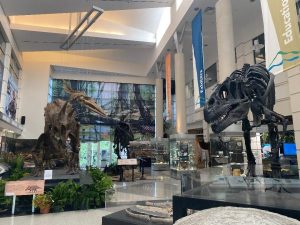 The upcoming Virginia Museum of Natural History (VMNH) branch campus in Waynesboro has reached another major milestone, as museum officials announced this week that VMNH has partnered with Richmond-based Glavé & Holmes Architecture to create the detailed designs of the new museum facility and to see the construction project through to completion.
The upcoming Virginia Museum of Natural History (VMNH) branch campus in Waynesboro has reached another major milestone, as museum officials announced this week that VMNH has partnered with Richmond-based Glavé & Holmes Architecture to create the detailed designs of the new museum facility and to see the construction project through to completion.
The announcement also provides additional details regarding the project’s timeline, with updated building drawings planned for release in late 2022, design completion scheduled for 2023, and groundbreaking tentatively targeted for 2024.
“This is an exciting development that signifies a new chapter in the VMNH-Waynesboro campus project,” said Dr. Joe Keiper, executive director of VMNH. “Glavé & Holmes Architecture has an outstanding track record of delivering incredible results for numerous cultural, educational, and civic institutions throughout the Commonwealth. We have the utmost confidence that, together, we will deliver a museum facility that will be an asset and place of pride for the entire region.”
During this new stage of the project, preliminary conceptual drawings will be updated with detailed designs that will address every aspect of the construction project, including the final appearance of the facility.
“As long time supporters of the museum community in Virginia, we are thrilled to have this opportunity to bring this exciting new museum to Waynesboro and the Shenandoah Valley, working in partnership with Verner Johnson, the exhibit design firm Riggs Ward, and an excellent team of professionals on this effort,” said Glavé & Holmes Architecture Senior Principal and Director of Cultural Studio Steven Blashfield. “We anticipate a design that will respond to this outstanding setting on the South River and reflect Virginia’s natural history in an inspiring new facility.”
To be located at the corner of W. Main and Arch Streets in Downtown Waynesboro, the VMNH-Waynesboro facility will consist of approximately 28,000 square feet of space, 20,000 of which will be dedicated to exhibit galleries and children’s learning and play areas. The facility will also include multiple classrooms, a science laboratory, and will provide a direct connection to the South River Preserve, while boasting numerous educational landscaping features.
“The Blue Ridge and Shenandoah Valley region of Virginia offers a tremendous opportunity to tell stories about its unique ecology, geology, and cultural and natural history,” said VMNH Trustee Dr. Thomas Benzing. “We’re excited to build these stories into every aspect of the VMNH-Waynesboro facility, from the indoor exhibit galleries to the outdoor landscaping features.”
Throughout the effort to bring a museum campus to Waynesboro, museum officials have worked closely with regional educators, colleges and universities, conservation organizations, and other community stakeholders to ensure that the upcoming facility maximizes benefits to the entire region. During the detailed design phase of the project, this level of collaboration will remain a priority.
“In the coming days, museum officials and regional stakeholders will meet with our newly formed team of architects, exhibit designers, landscape specialists and others to ensure that our lofty vision for the new VMNH-Waynesboro campus is fully realized,” said Keiper. “We’re excited to begin this process and look forward to continuing our engagements with the community in the weeks and months ahead.”
Virginia State Senator Emmett Hanger (R-Augusta County) has pushed the concept and funding for the branch museum through the Virginia General Assembly since first talks of its creation.
“Museum and local officials and interested organizations have collaborated to ensure this museum site will highlight Virginia’s unique natural history,” said Hanger. “The museum is going to be an economic boost and a wonderful educational component for not only this part of the Valley, but for all of our Commonwealth.”
The idea for establishing an interpretive center focused on natural resources can be traced back to the first Virginia Fly Fishing Festival initiated by Waynesboro Downtown Development Inc. in 2000. It is a direct outgrowth of their vision and significant contributions from the Shenandoah Valley Chapter of Trout Unlimited and Dominion Energy to build the education pavilion in Constitution Park, as well as the efforts of the Center for Coldwaters Restoration, a volunteer citizen group formed in 2010.
To learn more about the Virginia Museum of Natural History, visit www.vmnh.net.




